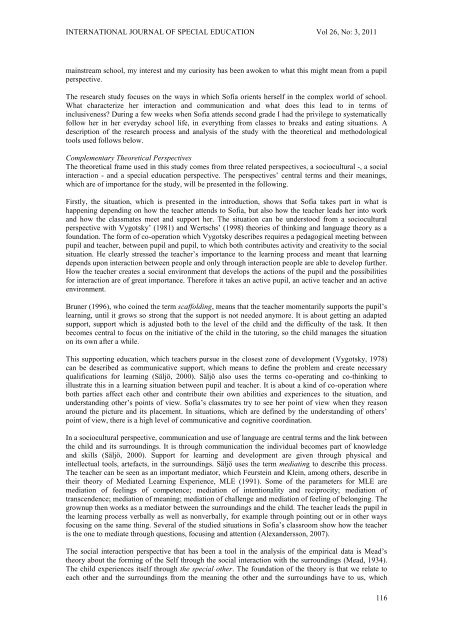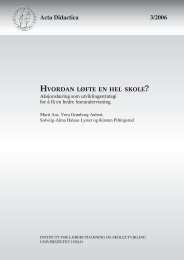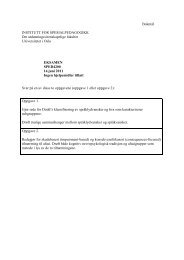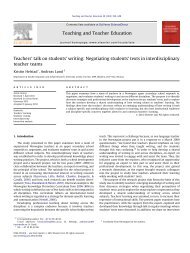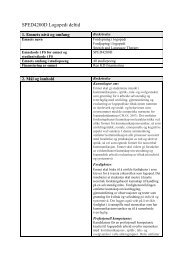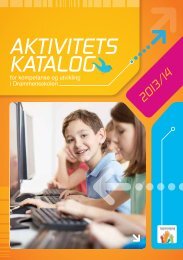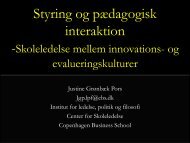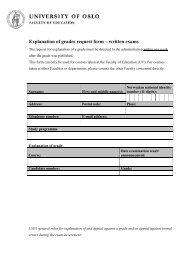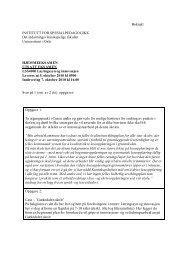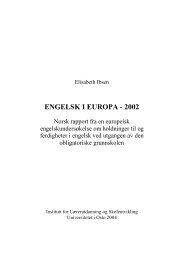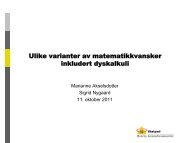International Journal Special Education
International Journal Special Education
International Journal Special Education
You also want an ePaper? Increase the reach of your titles
YUMPU automatically turns print PDFs into web optimized ePapers that Google loves.
INTERNATIONAL JOURNAL OF SPECIAL EDUCATION Vol 26, No: 3, 2011mainstream school, my interest and my curiosity has been awoken to what this might mean from a pupilperspective.The research study focuses on the ways in which Sofia orients herself in the complex world of school.What characterize her interaction and communication and what does this lead to in terms ofinclusiveness? During a few weeks when Sofia attends second grade I had the privilege to systematicallyfollow her in her everyday school life, in everything from classes to breaks and eating situations. Adescription of the research process and analysis of the study with the theoretical and methodologicaltools used follows below.Complementary Theoretical PerspectivesThe theoretical frame used in this study comes from three related perspectives, a sociocultural -, a socialinteraction - and a special education perspective. The perspectives’ central terms and their meanings,which are of importance for the study, will be presented in the following.Firstly, the situation, which is presented in the introduction, shows that Sofia takes part in what ishappening depending on how the teacher attends to Sofia, but also how the teacher leads her into workand how the classmates meet and support her. The situation can be understood from a socioculturalperspective with Vygotsky’ (1981) and Wertschs’ (1998) theories of thinking and language theory as afoundation. The form of co-operation which Vygotsky describes requires a pedagogical meeting betweenpupil and teacher, between pupil and pupil, to which both contributes activity and creativity to the socialsituation. He clearly stressed the teacher’s importance to the learning process and meant that learningdepends upon interaction between people and only through interaction people are able to develop further.How the teacher creates a social environment that develops the actions of the pupil and the possibilitiesfor interaction are of great importance. Therefore it takes an active pupil, an active teacher and an activeenvironment.Bruner (1996), who coined the term scaffolding, means that the teacher momentarily supports the pupil’slearning, until it grows so strong that the support is not needed anymore. It is about getting an adaptedsupport, support which is adjusted both to the level of the child and the difficulty of the task. It thenbecomes central to focus on the initiative of the child in the tutoring, so the child manages the situationon its own after a while.This supporting education, which teachers pursue in the closest zone of development (Vygotsky, 1978)can be described as communicative support, which means to define the problem and create necessaryqualifications for learning (Säljö, 2000). Säljö also uses the terms co-operating and co-thinking toillustrate this in a learning situation between pupil and teacher. It is about a kind of co-operation whereboth parties affect each other and contribute their own abilities and experiences to the situation, andunderstanding other’s points of view. Sofia’s classmates try to see her point of view when they reasonaround the picture and its placement. In situations, which are defined by the understanding of others’point of view, there is a high level of communicative and cognitive coordination.In a sociocultural perspective, communication and use of language are central terms and the link betweenthe child and its surroundings. It is through communication the individual becomes part of knowledgeand skills (Säljö, 2000). Support for learning and development are given through physical andintellectual tools, artefacts, in the surroundings. Säljö uses the term mediating to describe this process.The teacher can be seen as an important mediator, which Feurstein and Klein, among others, describe intheir theory of Mediated Learning Experience, MLE (1991). Some of the parameters for MLE aremediation of feelings of competence; mediation of intentionality and reciprocity; mediation oftranscendence; mediation of meaning; mediation of challenge and mediation of feeling of belonging. Thegrownup then works as a mediator between the surroundings and the child. The teacher leads the pupil inthe learning process verbally as well as nonverbally, for example through pointing out or in other waysfocusing on the same thing. Several of the studied situations in Sofia’s classroom show how the teacheris the one to mediate through questions, focusing and attention (Alexandersson, 2007).The social interaction perspective that has been a tool in the analysis of the empirical data is Mead’stheory about the forming of the Self through the social interaction with the surroundings (Mead, 1934).The child experiences itself through the special other. The foundation of the theory is that we relate toeach other and the surroundings from the meaning the other and the surroundings have to us, which116


